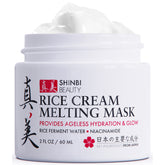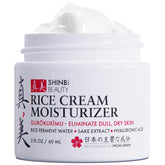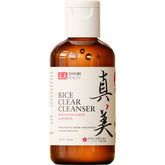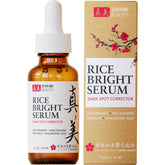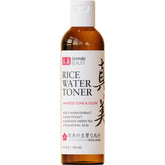Sake Extract With Kojic Acid Serum: A Powerhouse Duo!
Alright beauty buffs, clear off your vanities and cancel your evening plans!
Because we're about to unwrap the holy grail of J-Beauty, the secret sauce of Japanese skincare, the one and only power duo - sake extract with kojic acid serum.
If you're all about that glow life and are eagerly looking for the next big thing in your skincare routine, this could be it.
So, buckle up as we dive deep into the captivating world of sake!
Does sake contain kojic acid?
Let's lace up our science boots, tighten our detective goggles, and dive right into the depths of this intriguing question.
First things first, let's get straight on what kojic acid is.
Within the broad tableau of organic compounds, kojic acid is a veritable rockstar. It's a by-product of several fermentation processes and was first discovered in Japan in 1907.
But, what's so special about kojic acid?
In simple terms, it's a bit like a skincare fairy godmother.
It's a popular ingredient in numerous beauty and cosmetic products, lauded for its ability to lighten visible sun damage, age spots, or scars. This mild inhibitor of melanin literally brightens up your day, or more aptly, your complexion.
So back to our million-dollar question: is this skincare superstar found in sake?
As a matter of fact, it is.
Sake, that renowned oriental nectar, is a fermented rice wine, a potent drink with a rich and colorful cultural history in Japan.
And it's within this delightful drink that the source of the fermentation, a mold named Aspergillus oryzae, and more specifically, its enzymes, start working wonders.
You see, during sake brewing, the molds start breaking down the rice starches into sugars. But along the way, they perform a tiny magic trick, producing not just alcohol but also our beloved kojic acid.
But what does this mean for you, the sake sipper?
You might be thinking, can I still drink sake if it contains kojic acid?
The answer is an emphatic yes! The levels present in sake are negligible regarding any adverse impact on your health. You'd have to consume a veritable ocean of sake for the kojic acid to present any risk.
More importantly, can this kojic acid in sake benefit your skin?
If you mean physically putting sake on your face? Probably not. But using specialist kojic-acid-infused serums? That’s another story altogether.
So, keep sipping your sake and leave the hard skincare work to your beloved kojic acid-rich potions.
Can you use sake extract and kojic acid serum together?
Ah, the beauty junkie's conundrum!
We've all been there, cocking our heads to one side as we consider the duo of promising bottles on our vanity.
The pungent aroma of the sake extract and the undeniable glow promised by the kojic acid serum.
Can they…should they...be used together?
Let's unveil the details, shall we?
Sake extract, first off, is a potent cocktail derived from fermented rice. It's been an age-old skincare secret of Japanese geishas that modern science has pinned down to the presence of essential amino acids and enzymes.
Now, these little beauties work in a threefold way.
They hydrate - trapping moisture in the skin, they brighten - gently exfoliating to reveal fresh skin, and they protect - guarding your skin from pesky environmental damage. Sake extract is a little like that overachieving friend who somehow juggles a full-time job, spin classes, and baking macarons on weekends.
Kojic acid serum, on the other hand, is a standout in the discoloration banishing business.
Hailing from several types of fungi, one of which is used in sake production (conveniently named koji!), it's been lauded as a safer alternative to the controversial skin-brightener hydroquinone.
Its primary function is to inhibit tyrosinase, the enzyme responsible for melanin production. That means it slows down pigment formation, effectively lightening hyperpigmentation and evening out skin tone.
However, kojic acid lives life on the edge. It's powerful but volatile - it loves to break down and lose its effectiveness when exposed to light and heat. So, consider it your high-maintenance skincare diva.
Sounds like a fabulous team, right?
There is indeed a certain appeal to using these two skincare wonders together. After all, both compounds originate from the same Japanese fermentation process.
The science here is as enticing as it is fascinating. Sake, the hydrating multitasker, prepping and priming the skin. Kojic acid, the maverick pigment-fighter, swooping in on its brightening mission. This is complementary action at its finest.
But hold on to your roses, dear readers. Skin care is not a one-size-fits-all deal - we are glorious in our diversity after all.
While sake extract and kojic acid can make a powerful pair, some skin types might find the combo irritating. So always patch test, lovelies. And do check in with your dermatologist before adding another gig to your skin-care band.
Can you use sake as a toner?
Get ready, skincare enthusiasts!
Now, the idea of using sake (yes, the Japanese rice wine) as a toner might sound a tad wild and unorthodox. But trust me, it's uncertainty worth investigating!
Yes, unequivocally yes. You can — and absolutely should — use a toner with sake extract.
But why, you may query?
Right, enough suspense!
Far from just fading hyperpigmentation (although, as we’ve seen, it does that marvelously too), kojic acid doubles as an antioxidant. It pitches a tent on your skin and stands guard, shielding you from environmental damage, like a valiant skincare knight you never knew you had! It's a win-win, isn't it?
We're not done yet. There's more!
Sake extract is rich in enzymes that gently nudge away dead skin cells without the harshness of a scrub. So, it's potent but tender on your skin, a balance that any toner worth its salt (or rice, in this case) needs to strike.
"But won’t it dry out my skin?" I hear you ask.
Instinctively, you might think so, given sake’s an alcoholic drink. But as it turns out, the answer is: not at all!
Sake extract maintains the skin’s natural moisture balance, a vital factor when using a toner. Unlike alcohol-based toners that can leave your skin feeling like a Nevada desert, sake keeps the hydration on lock, enhancing that dewy glow.
Are there antioxidants? Check. Exfoliation? Check. Hydration? Check.
Clearly, sake is no ordinary rice wine when it comes to skincare. From balancing your skin tone to maintaining hydration, it’s a silent champion of the toner hunt.
Sounds rosy, right? Just one final caveat before you raid your liquor cabinet (just kidding - please don’t put actual sake on your face).
Though undeniably beneficial, sake might be too potent for some skin types. We all dance to our own skin rhythm, right?
So, before making a splash, do a small patch test on your wrist or behind your ear. It’ll give you an idea if your skin enjoys sake as much as your palate does.
So, there you have it! Sake as a toner? Ready, steady, glow!
Go on, give sake toner a shot. Layer with caution, but slay with confidence.
Look at you, unlocking international skincare secrets and pushing boundaries, one sake bottle at a time!
What are the disadvantages of kojic acid on your skin?
As we now know, kojic acid is a stalwart component in our dermatological arsenal against hyperpigmentation, those pesky dark spots, and a complexion as unbalanced as a seesaw.
But take note, folks! This skin savior is not without its capricious quirks.
Kojic acid, while a celebrated heavyweight in the pigment fight, may pack a bit too much punch for some skin types.
Overzealous use or overly concentrated applications could leave your skin staging a protest in the form of irritation, that all-too-familiar itchiness or unsightly redness.
The moral of the story? 'Go easy,' they say. This is no marathon, and moderation is key.
Now, if you think we're suggesting you hold off on using kojic acid altogether, you'd be mistaken. We're not nixing it, merely advocating for strategic teamwork. Leverage the mellow viscosity and hydrating prowess of sake extract to coax kojic acid into being a bit more skin-friendly.
It's about finding the yin to the kojic acid yang and striking that perfect, skin-loving harmony.
Here's the crunchy nugget of truth for us skincare aficionados - no two batches of skin cells are cut from the same cloth.
Our epidermis throws us curve balls and complications, all of which require our nimble thinking.
That’s why we swear by the age-old wisdom of patch-testing any new product. Dab a little behind your ear or on the inside of your elbow and wait for 24 hours to see if your skin reacts.
Closing the chapter on our J-Beauty journey, we now find ourselves armed with more knowledge on the amusing, and slightly mysterious, relationship between the unassuming sake extract and the powerful kojic acid serum.
Well-informed and ready to explore, you are now prepared to venture into the adventurous realms of Japanese skincare. This land where the dewy complexions bloom and skin radiates brighter than the morning sun, awaits you.
A journey of skincare discovery
With inquisitive minds and a thirst for knowledge, we continue to grow in our skincare journey — navigating through uncertainties, embracing challenges, and celebrating victories as we bask in our ever-improving skin health.
And remember, 'Glowing and growing’ is our skin-care mantra. Step by step, drop by drop.
Let’s toast to that, shall we?


